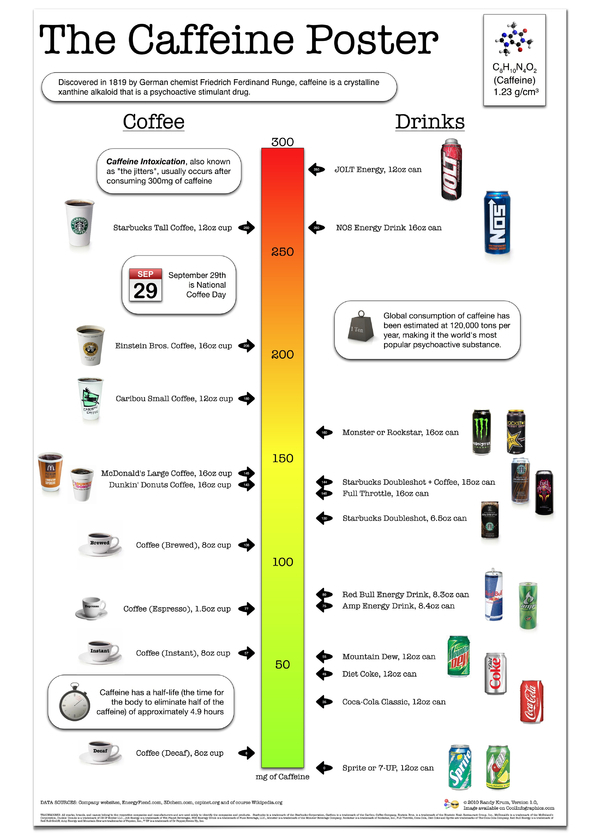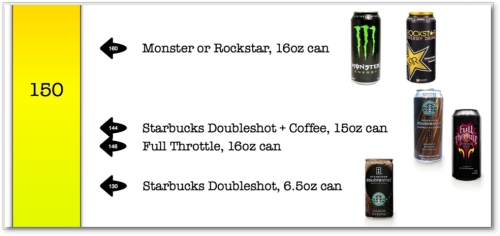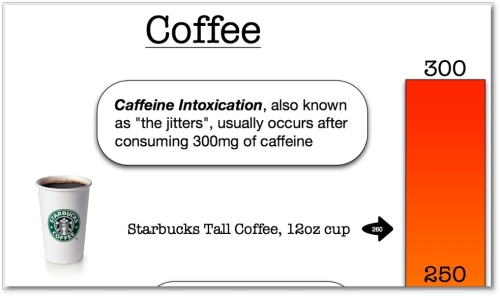The Caffeine Poster, How Much Caffeine Are You Drinking? [new infographic]
You are what you drink. With so many drinks today claiming to be “energy drinks”, I wanted a little visual clarification, so I made The Caffeine Poster. With coffee drinks on one side and canned cold drinks on the other, you can quickly see how much of a caffeine “hit” (in mg) you will get after consuming. What’s especially interesting is many of the drinks have a very high caffeine mg/oz ratio, but the drink is so small you don’t get that much total caffeine.
I’ve been working on my own infographic for 6 months now off-and-on when I can make time. I figured that I’ve been running this infographic blog for a few years now, it’s time to start putting up my own work. Most of the data visualization I’ve designed are confidential to the company I make them for, so I wanted to create some infographics that I can publish on the blog.
The Caffeine Poster is supposed to help with one decision in your life. If you’re going to grab a caffeine drink during the day (or evening), which drink should you consume? I tried to stay focused on telling one story really well. I’ve heard from others that this may make for a really good infographic, but may not make a great poster because a good poster would have a much deeper level of detail. I like it, and we’ll see what king of responses I get.
I absolutely want to hear your feedback. Please add your comments below or send me a note. What do you think? I’ve also got requests to print and offer this as a poster. We’ll see if there is enough interest…
Also, I’m planning to post as “Making-of” article on what it took to create this infographic.
Making-Of The Caffeine Poster - Part 1
Making-Of The Caffeine Poster - Part 2
Making-Of The Caffeine Poster - Part 3
THANKS: A big thanks to Fast Company for posting about The Caffeine Poster on the Fast Company blog. The Caffeine Poster was the most popular story of the week on Fast Company!









 Randy
Randy




Reader Comments (23)
Really nice job! Some suggestions for enhancements as a practical beverage-evaluation tool:
- I would have liked to see the same oz numbers in the coffee shop examples: e.g., seeing them all at 16oz would make it much easier to compare brand-to-brand (I had to calculate offline to see that Starbucks was more than twice as strong as Dunkin donuts).
- In practice, the hard thing when evaluating the energy drinks is comparing the levels of all the other stimulants as well. So even though it's not caffeine information, I'd like to see something like columns to the right of the energy drinks to show the sugar/guarna/ginseng/etc levels.
- This may be out of scope, but for me sometimes it boils down to finding the maximum caffeine-per-dollar value. Prices obviously vary widely by geography; but it would be interesting to see the price-per-mg adjusted rankings - i.e., what's the most bang for your buck?
cheers,
-Ped
Some of your figures are misleading. While manufacturers may control the amount of caffeine which goes into a commercial product, home brewed drinks may actually contain a *range* of caffeine. The amount of caffeine in my home brewed cup of coffee probably depends on variables such as the brew time, brew method, etc. According to the Mayo Clinic, "generic brewed" coffee may contain 95-200mg of caffeine.
You should also mention Tea (Black, green, etc) as well. Many people switch from coffee to tea because they believe it contains less caffeine. However, this is not always the case. Black Tea contains 40-120mg of caffeine per serving, which puts it in the middle of the chart. A cup of tea may contain more caffeine then a shot of espresso.
See http://www.mayoclinic.com/health/caffeine/AN01211.
Well, firstly, I'd be very interested in a 'Making Of' article.
Secondly it makes a fine poster, depending on the market. It feels like it would fit right in in the ThinkGeek caffeine section, for example. Perhaps needs to be a bit more exciting to look at, though, although I'm not sure how to accomplish that. It doesn't immediately catch the eye.
I can see the appeal of standardising the serving size (Caffeine per oz or whatever), but that just adds to the work the reader has to do. It's far easier to use this as an 'at a glance' provider of information if it lists everything in their standard serving size. It makes it an "I'm about to go to lunch, which thing should I buy?"
It could be nice to have a supplementary piece of information on sugar and other stimulants, but I can see how this would distort the core message of the poster, and perhaps just add clutter. It's something to consider but my default behaviour is to eliminate unnecessary things on a design like this.
It depends how far you want to take this, but you've sewn the seeds of the next step in the evolution of this graphic in your narrative. Along one axis, the absolute quantity of caffeine in mg, and along a second perpendicular axis, the size of the drink or the density (you might try both to see which tells the story best). You could lose the cheesy arrows (I do appreciate that you have them clarifying the precise dosage) and use the actual can/cup images as the markers, or failing that some tight leader-lines to the edge of the graph where the images would rest.
Anyway, you're doing good work with this blog. I wonder if Edward Tufte has joined any of your discussions or if you have joined any of his...
Very good job and great overview, which in my opinion is the most important aspect in infographic.
I fully agree with Kim Toufectis, next step is a try with carthesian axis with caffeine quantity and the drink size (density I think wolud be too difficult to fulfill and also to explicate). But you'd better try to distinguish these two values with two different colours
anyway my congratulations
...but...but...but where's the tea?
It might be nice to drop in a standard mug of tea, and also a standard dark chocolate bar (70%) in - the tea obviously on the left. Very nice looking, and clear (says the non-designer in te commentary, so I apologise for lack of useful design points!).
Nice! Could include "caffeine per ounce" in the arrow (and possibly more legible type). Previously mentioned tea and chocolate also good. French press, now offered by several local shops, would be good. Really like the graphics, especially like the half-life info. Thanks!
dude, where's TEA in this scale?!?!?
I know I left tea out of the graphic (along with thousands of other drinks). It was actually hard to cull down the wide assortment of drinks down to only the ones I included. Not a tea drinker myself, tea didn't make the cut (Kevin Rose would be disappointed, I know). I'll explain more in the Making-Of post. but it's very crowded in the under 100mg space.
FWIW, tea averages between 40-70mg of caffeine in each 8oz cup
Thanks for the comments!
Since caffeine content is not required to be included in the Nutrition Facts, few companies do. Some of these companies do have their caffeine content published on their websites, but others I had to find from sources like energyfiend.com.
I agree that the true content is somewhat variable each time you brew coffee or a company mixes the drink formula. Like everything in the Nutrition Facts, these should be considered as averages.
I thought Mountain Dew was higher up on the caffeine scale.
This poster reminds me of my days working in the college wellness center. I swore once that I would never drink coffee then - life changes things I suppose. Then again, the antioxidants in coffee are quite good for you.
I've seen a number of comments that suggest I should have standardized the volume of each drink instead of leaving the drinks at their original sizes (i.e. all drinks calculated at 12oz vs. 16oz, 12oz, 8oz, etc.)
I struggled with this early in the design, and I really believe I made the right choice to leave the volumes alone and representative of how a consumer would buy and consume each drink. A 12oz cup from Starbucks really does have more caffeine than a 16oz cup at Einstein Bros, and if you buy your coffee from Einstein in the morning, you're going to drink all 16oz.
This is especially true for the canned drinks. I could have calculated them all to 12oz (a standard soda can), but then you would have to drink 1.45 cans of Red Bull. I'm pretty sure no one is going to do that.
Great poster. My one suggestion would be to include an entry for espresso in some form - maybe a Tall Latte from Starbucks (1 shot espresso), a Grande (2 shots), etc. I was surprised to see that a Grande drip coffee from Starbucks contains 330 mg of caffeine, while a Grande espresso drink (latte, americano) contains only 225. This would probably surprise many people and thus be an interesting addition to your poster. Check here: http://www.starbucks.com/retail/nutrition_beverages.asp for official amounts from Starbucks.
Excellent demonstration and one where I will refer to it from time to time. Really appreciated!
Anyway, if I go on for more than a day and have 2 - 3 cups toward the end of the shift I get the Jitters. I don't drink caffeine that much other than the usual 1 cup per day of instant roasted good coffee on a regular basis - no more. Some days I don't have any coffee but just nice brewed tea.
But as the saying goes you are what you eat/drink/think.
Thanks!
Feeling Run Down
Hehe am I actually the only comment to your amazing writing.
If only more people could read about this..
wow outstanding post well done.
Excellent demonstration and one where I will refer to it from time to time. Really appreciated!
Anyway, if I go on for more than a day and have 2 - 3 cups toward the end of the shift I get the Jitters. I don't drink caffeine that much other than the usual 1 cup per day of instant roasted good coffee on a regular basis - no more. Some days I don't have any coffee but just nice brewed tea.
But as the saying goes you are what you eat/drink/think.